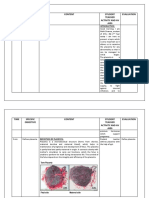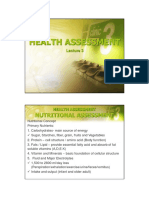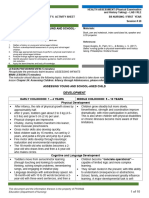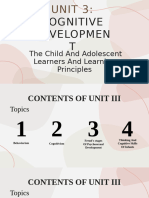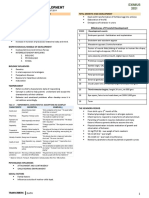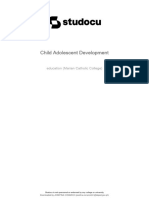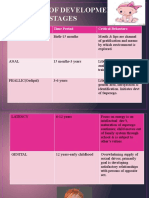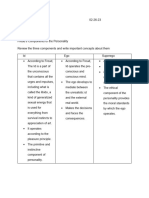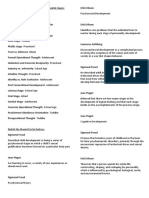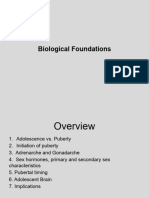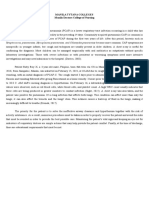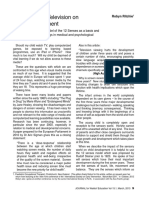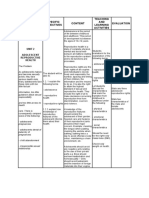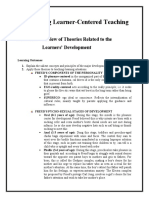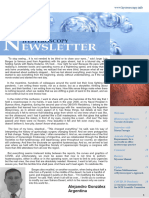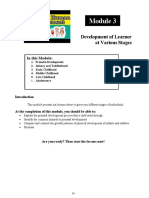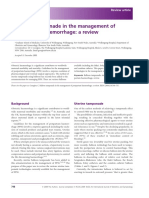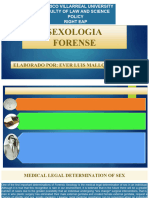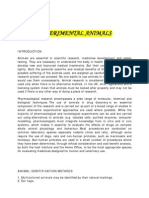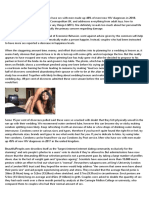Maternal and Child Health Nursing, 8th Edition
Maternal and Child Health Nursing, 8th Edition
Uploaded by
Erica Marie H FabrigasCopyright:
Available Formats
Maternal and Child Health Nursing, 8th Edition
Maternal and Child Health Nursing, 8th Edition
Uploaded by
Erica Marie H FabrigasOriginal Description:
Original Title
Copyright
Available Formats
Share this document
Did you find this document useful?
Is this content inappropriate?
Report this DocumentCopyright:
Available Formats
Maternal and Child Health Nursing, 8th Edition
Maternal and Child Health Nursing, 8th Edition
Uploaded by
Erica Marie H FabrigasCopyright:
Available Formats
Care of Mother, Child and Adolescent (Well-
Clients)
STUDENT ACTIVITY SHEET BS NURSING / SECOND YEAR
Session # 23
LESSON TITLE: THE FAMILY WITH AN ADOLESCENT
Materials:
Book, pen, notebook and SAS
LEARNING OUTCOMES:
At the end of the lesson, the student nurse can:
1. Describe the growth and development of an adolescent.
Reference:
2. Assess the adolescent for normal growth and
development
Pilliteri, Adele and Silbert-Flagg, JoAnne (2018)
3. Identify the parental concerns in the care of an
Maternal and Child Health Nursing, 8th Edition.
adolescent.
USA: Lippincott Williams and Wilkins
4. Provide health teachings for parents on the care for an
adolescent
LESSON REVIEW/PREVIEW (5 minutes)
MAIN LESSON (45 minutes)
Please refer to Chapter 32: Nursing Care of a Family with a School-Age Child p.855
GROWTH AND DEVELOPMENT OF AN ADOLESCENT
DEFINITIONS: SEXUAL MATURATION IN GIRLS
ADOLESCENCE- begins with gradual appearance of 2ary THELARCHE- breast development (9-13 ½)
sex characteristics at 11 to 12 years old & ends with ADRENARCHE- pubic hair
cessation of body growth at 18 to 20 yrs. old MENARCHE- ist menstruation 2 yrs after
changes(9 ½ to 12 years old)
PUBERTY- the maturational, hormonal & growth OVULATION- 6 to 14 mos after MENARCHE
processes that occur when the reproductive organs begin Growth spurt
to function & the secondary sex characteristics begin to Widening of the hips
develop (3 stages) Vaginal secretions increase
Axillary hair
PREPUBESCENCE- 2 years before puberty
SEXUAL MATURATION IN BOYS
PUBERTY- sexual maturity is achieved; menarche enlargement & thinning, reddening &
increasing looseness of scrotum (9 ½-14 yo)
POSTPUBESCENCE-1-2 yrs after puberty Pubic hair, axillary & facial hair
Penile enlargement
3 PHASES OF ADOLESCENCE: Increasing muscularity
Voice changes
EARLY ADOLESCENCE- 11-14 yrs old GYNECOMASTIA
Growth spurt
MIDDLE ADOLESCENCE- 15 to 17 yrs old NOCTURNAL EMISSIONS
SPERMATOGENESIS
LATE ADOLESCENCE- 18 to 20 yrs old
PHYSICAL GROWTH
ACNE
APOCRINE SWEAT GLANDS active
GROWTH SPURT- extremities & neck first
This document and the information thereon is the property of PHINMA
Education (Department of Nursing) 1 of 5
SOCIAL DEVELOPMENT PLAYS AND GAMES
IDENTITY VS ROLE CONFUSION LEISURE/RECREATIONA L ACTIVITIES
Easily influenced into forming concept of self; PARTIES, OUTING, PICNICS, MOVIES
choose ROLE MODELS & avoid Labeling FANTASY & DAYDREAMING
PEER GROUP influence TELEPHONE CONVERSATIONS
Vacillates between considerable maturity COMPUTER GAMES
&childlike behavior READING ROMANCE NOVELS
MOOD SWINGS SPORTS
AMBIVALENCE bw independence & fear of HOBBIES
responsibilities
PROBLEMS WITH ADOLESCENTS
COGNITIVE DEVELOPMENT Fatigue, poor posture
ABSTRACT THINKING- no longer restricted ACNE VULGARIS
to the real & actual (CONCRETE) but also SUICIDE
considers the possibilities DRUG EXPERIMENTA TION
FORMAL OPERATIONAL AGE ALCOHOLISM
Scientific reasoning
Can imagine thinking other than their own CAUSES OF INJURIES
MOTOR VEHICULAR ACCIDENTS
MORAL DEVELOPMENT SPORTS ACCIDENTS
INTERNALIZED SET OF MORAL DROWNING
PRINCIPLES- refers to moral code ALCOHOL
DRUGS
SUICIDE
TEENAGE PREGNANCY
CHECK FOR UNDERSTANDING (25 minutes)
You will answer and rationalize this by pair. This will be recorded as your quiz. One (1) point will be given to correct
answer and another one (1) point for the correct ratio. Superimpositions or erasures in you answer/ratio is not allowed.
Multiple Choice
1. The parents of an adolescent boy are concerned about the amount of sleep he seems to require. What advice
would you give them?
A. “As long as he seems otherwise well, this sounds like a typical teenager. ”
B. “Adolescents only need 8 hours of sleep a night; anything over this is excessive.”
C. “Your son is probably engaged in too many activities and is wearing himself out. ”
D. “Your son may be taking drugs; the side effect of many drugs is to cause sleepiness. ”
ANSWER: ________
RATIO:__________________________________________________________________________________________
_________________________________________________________________________________________________
_______________________________________________________________ _______________________
2. The nurse working with adolescents understands which to be the most widely used drug among adolescents?
A. Alcohol
B. Heroin
C. Cocaine
D. Speed
ANSWER: ________
RATIO:__________________________________________________________________________________________
_________________________________________________________________________________________________
_______________________________________________________________ _______________________
3. When encouraging an adolescent who is hospitalized and physically challenged or chronically ill to develop
and maintain a sense of identity, which is the best nursing action?
A. Providing the opportunity for individual decision making
B. Providing physical comfort to the individual
C. Asking the parents what the adolescent is capable of doing
D. Providing care until the adolescent insists on being independent
ANSWER: ________
This document and the information thereon is the property of PHINMA
Education (Department of Nursing) 2 of 5
RATIO:__________________________________________________________________________________________
_________________________________________________________________________________________________
______________________________________________________________________________________
4. The following is/are fears of adolescents. Which is the LEAST common?
A. hospitalization
B. Acne
C. Obesity
D. Death
ANSWER: ________
RATIO:__________________________________________________________________________________________
___________________________________________________ ______________________________________________
______________________________________________________________________________________
5. Fred, age 14, considers which of these persons as most important?
A. girlfriend
B. classmates
C. mother
D. professor
ANSWER: ________
RATIO:__________________________________________________________________________________________
_________________________________________________________________________________________________
______________________________________________ ________________________________________
6. Fifteen-year-old Janice makes an unprovoked rude gesture to a staff member of the university. It most likely
indicates that she is___
A. manipulative
B. threatening to others
C testing boundaries
D. showing signs of immaturity
ANSWER: ________
RATIO:__________________________________________________________________________________________
_________________________________________________________________________________________________
______________________________________________________________________________________
7. The female adolescent will likely show signs of pubertal changes such as menstruation. What is the term used
for the first menses?
A. dysmenorrhea
B. menarche
C. menopause
D. menorrhagia
ANSWER: ________
RATIO:__________________________________________________________________________________________
_________________________________________________________________________________________________
______________________________________________ ________________________________________
8. Which is least likely a characteristic of puberty in boys?
A. enlargement of the testes
B. pubic and axillary hair
C. nocturnal emission
D. enlargement of the prostate
ANSWER: ________
RATIO:__________________________________________________________________________________________
_________________________________________________________________________________________________
_______________________________________________________________ _______________________
9. Piaget’s cognitive theory in adolescence identifies which of these behaviors?
A. object permanence
B. abstract thinking
C. animism
D. global organization
ANSWER: ________
This document and the information thereon is the property of PHINMA
Education (Department of Nursing) 3 of 5
RATIO:__________________________________________________________________________________________
_________________________________________________________________________________________________
_______________________________________________________________ _______________________
10. Which of these statements characterize the formal operations stage according to Piaget?
A. The child develops logical thought.
B. The child begins to understand the environment.
C. The child develops abstract thinking
D. The child has difficulty separating fantasy from reality.
ANSWER: ________
RATIO:__________________________________________________________________________________________
_________________________________________________________________________________________________
_______________________________________________________________ _______________________
RATIONALIZATION ACTIVITY (THIS WILL BE DONE DURING THE FACE TO FACE INTERACTION)
The instructor will now rationalize the answers to the students. You can now ask questions and debate among yourselves.
Write the correct answer and correct/additional ratio in the space provided.
1. ANSWER: ________
RATIO:_______________________________________________________________________________________
_____________________________________________________________________________________________
_____________________________________________________________________
2. ANSWER: ________
RATIO:_______________________________________________________________________________________
_____________________________________________________________________________________________
_____________________________________________________ ________________
3. ANSWER: ________
RATIO:_______________________________________________________________________________________
_____________________________________________________________________________________________
_____________________________________________________________________
4. ANSWER: ________
RATIO:_______________________________________________________________________________________
_____________________________________________________________________________________________
_____________________________________________________________________
5. ANSWER: ________
RATIO:_______________________________________________________________________________________
_____________________________________________________________________________________________
_____________________________________________________________________
6. ANSWER: ________
RATIO:_______________________________________________________________________________________
_____________________________________________________________________________________________
_____________________________________________________________________
7. ANSWER: ________
RATIO:_______________________________________________________________________________________
_____________________________________________________________________________________________
_____________________________________________________________________
8. ANSWER: ________
RATIO:_______________________________________________________________________________________
_____________________________________________________________________________________________
_____________________________________________________________________
9. ANSWER: ________
RATIO:_______________________________________________________________________________________
_____________________________________________________________________________________________
_____________________________________________________________________
10. ANSWER: ________
RATIO:_______________________________________________________________________________________
_____________________________________________________________________________________________
_____________________________________________________________________
This document and the information thereon is the property of PHINMA
Education (Department of Nursing) 4 of 5
LESSON WRAP-UP (5 minutes)
You will now mark (encircle) the session you have finished today in the tracker below. This is simply a visual to help you
track how much work you have accomplished and how much work there is left to do.
You are done with the session! Let’s track your progress.
Period 1 Period 2 Period 3
1 2 3 4 5 6 7 8 9 10 11 12 13 14 15 16 17 18 19 20 21 22 23
AL STRATEGY: CAT: Student Response Cards
1. The instructor will give you response card and will explain the choices that was included with the card.
2. The Instructor will give a question to the class regarding information just covered in your lesson.
3. Hold up your card with the corresponding answer to the instructor’s question.
This document and the information thereon is the property of PHINMA
Education (Department of Nursing) 5 of 5
You might also like
- Handouts Psych Mr. Kevin Andrei FajardoDocument13 pagesHandouts Psych Mr. Kevin Andrei FajardomycovesmaneNo ratings yet
- Theories Related To The Learner's DevelopmentDocument30 pagesTheories Related To The Learner's DevelopmentMichael Moreno84% (37)
- Gender Sensitivity Training (GST) : Department of EducationDocument97 pagesGender Sensitivity Training (GST) : Department of EducationFer Grace AniñonAcabalcuid Cataylo100% (1)
- Masturbate A ThonDocument3 pagesMasturbate A Thonsuzy0% (1)
- Placental ExaminationDocument12 pagesPlacental ExaminationNidhi Sharma100% (7)
- Domains of Moral Development LSDDocument84 pagesDomains of Moral Development LSDYashika Jain -63No ratings yet
- Concept of Growth and DevelopmentDocument31 pagesConcept of Growth and DevelopmentApRil Anne BalanonNo ratings yet
- Child DevelopmentDocument44 pagesChild DevelopmentJammille BiagtanNo ratings yet
- Child and Adolescent Learning PrinciplesDocument25 pagesChild and Adolescent Learning Principlestristanalameda123No ratings yet
- Health AssessmentDocument47 pagesHealth AssessmentDayeNo ratings yet
- Middle and Late ChildhoodDocument47 pagesMiddle and Late ChildhoodJerine Bonus ApostolNo ratings yet
- 1 Module 1 - Concept and Nature of Self: Who Am I?Document9 pages1 Module 1 - Concept and Nature of Self: Who Am I?John MichaelNo ratings yet
- HA Lab SAS300youngDocument10 pagesHA Lab SAS300youngCallie ParkNo ratings yet
- BLEPT ProfEd Child-Adulthood Facilitating Learning - Emboltura PDFDocument18 pagesBLEPT ProfEd Child-Adulthood Facilitating Learning - Emboltura PDFamareia yapNo ratings yet
- Chapter 1. Development Autosaved 1Document23 pagesChapter 1. Development Autosaved 1Judyangaangan03No ratings yet
- Child and Adolescent Learning PrinciplesDocument126 pagesChild and Adolescent Learning Principlestristanalameda123No ratings yet
- Pedia - Growth and DevelopmentDocument6 pagesPedia - Growth and DevelopmentIsabel CastilloNo ratings yet
- Is This Normal or ADHDDocument52 pagesIs This Normal or ADHDDianaNo ratings yet
- Child Psychology PedodonticsDocument44 pagesChild Psychology Pedodonticsswechchha gupta100% (1)
- Taking History and Physical Examination in YouthDocument99 pagesTaking History and Physical Examination in Youthlinda ratna watiNo ratings yet
- Finals Reviewer DevpsychDocument15 pagesFinals Reviewer DevpsychcaraaatbongNo ratings yet
- Child Adolescent DevelopmentDocument11 pagesChild Adolescent DevelopmentEricka joy conarcoNo ratings yet
- Abnormal Pedia ReviewerDocument6 pagesAbnormal Pedia ReviewerMarwin OditaNo ratings yet
- Schizophrenia Case StudyDocument8 pagesSchizophrenia Case StudyJohn Carlo Toledo0% (1)
- STAGES+OF+HUMAN+DEV-+CiccarrelliDocument2 pagesSTAGES+OF+HUMAN+DEV-+Ciccarrellihappiness1234No ratings yet
- Reviewer in Dev PsychDocument18 pagesReviewer in Dev PsychocampofranccineNo ratings yet
- Theories of Development Freudian Stages: Developmental Stage Time Period Critical BehaviorsDocument84 pagesTheories of Development Freudian Stages: Developmental Stage Time Period Critical BehaviorsYhen TacNo ratings yet
- Physical Development of High School LearnersDocument49 pagesPhysical Development of High School LearnersDiana Garcia SaclutiNo ratings yet
- Ha Lab Sas 28 Alferez Jeysan Mae PDFDocument11 pagesHa Lab Sas 28 Alferez Jeysan Mae PDFCallie ParkNo ratings yet
- Module 1Document11 pagesModule 1Kel LumawanNo ratings yet
- Development TestDocument18 pagesDevelopment TesthypsdreamerNo ratings yet
- Human DevtDocument37 pagesHuman DevtJamesAnthonyNo ratings yet
- INFOGRAPHDocument3 pagesINFOGRAPHJADE PATEGANo ratings yet
- 19 Principles of Growth and DevelopmentDocument50 pages19 Principles of Growth and DevelopmentBryan Lloyd Ballestar RayatNo ratings yet
- AdolescenceDocument11 pagesAdolescenceMarybell AycoNo ratings yet
- Focus On The LearnerDocument59 pagesFocus On The LearnerFrance BejosaNo ratings yet
- Personal Development Reviewer PDFDocument2 pagesPersonal Development Reviewer PDFRaineee hatdogNo ratings yet
- Psy 2 - FDocument2 pagesPsy 2 - FMae Racquel Grace RamosNo ratings yet
- Reviewer (Developmental Theories & Relevant Theories) Freud'S Psychoanalytic TheoryDocument31 pagesReviewer (Developmental Theories & Relevant Theories) Freud'S Psychoanalytic TheoryJonalyn OrtegaNo ratings yet
- Adolescence-Between Childhood and AdulthoodDocument45 pagesAdolescence-Between Childhood and AdulthoodAnna CabreraNo ratings yet
- 9 Developmental Lecture NotesDocument33 pages9 Developmental Lecture NotesReseNo ratings yet
- Sarahina CI EDUC2 A2Document8 pagesSarahina CI EDUC2 A2sarahinacamilaNo ratings yet
- TFN Q1Document3 pagesTFN Q1Rix PelarejaNo ratings yet
- Biological Foundations Lecture 2022Document19 pagesBiological Foundations Lecture 2022roubaieerenNo ratings yet
- BSN 2 1 Grand Case PCAP CDocument30 pagesBSN 2 1 Grand Case PCAP CVinzii DrtNo ratings yet
- Child and Adolescent Full PPT 11Document45 pagesChild and Adolescent Full PPT 11jelleenantonio7No ratings yet
- Child and Adolescent Development PDFDocument118 pagesChild and Adolescent Development PDFArcie CatliNo ratings yet
- Human Devlopment 1: Level 1Document27 pagesHuman Devlopment 1: Level 1Rahul Kumar DiwakarNo ratings yet
- Nzjournal 15.1ritchieDocument4 pagesNzjournal 15.1ritchieDananjaya PranandityaNo ratings yet
- The Well ChildDocument25 pagesThe Well ChildElvis JinjikaNo ratings yet
- Early AdulthoodDocument7 pagesEarly AdulthoodColeen DajonNo ratings yet
- Emotional Development From Infancy To AdolescenceDocument17 pagesEmotional Development From Infancy To AdolescenceRumesa Yousuf100% (2)
- Development Guided NotesDocument8 pagesDevelopment Guided NotesMuntaha LolNo ratings yet
- Mind MapDocument2 pagesMind MapAndrea RojasNo ratings yet
- Children 13th Edition Santrock Solutions ManualDocument29 pagesChildren 13th Edition Santrock Solutions Manualbinhlinhh9ih100% (37)
- Adolescent Reproductive HealthDocument1 pageAdolescent Reproductive HealthGood BoyNo ratings yet
- 2 Months Well Child CheckDocument3 pages2 Months Well Child CheckJanelleNo ratings yet
- Facilitating Learner-Centered Teaching: Module 3 - Review of Theories Related To The Learners' DevelopmentDocument15 pagesFacilitating Learner-Centered Teaching: Module 3 - Review of Theories Related To The Learners' DevelopmentLou Jane YescaNo ratings yet
- (PEDIA) AdolescenceDocument11 pages(PEDIA) AdolescenceAlex OndevillaNo ratings yet
- Pediatric Nursing Lecture 59 Pages Pg. 274 332Document58 pagesPediatric Nursing Lecture 59 Pages Pg. 274 332ShiraishiNo ratings yet
- Module 2 - Developing The Whole PersonDocument91 pagesModule 2 - Developing The Whole PersonArchi Archi100% (3)
- Factors of Human DevelopmentDocument5 pagesFactors of Human DevelopmentKarmelaÜCastilloNo ratings yet
- Desktop Manual of Childhood Psychotherapy © For: Therapists, Pediatricians, and Parents - Final FormFrom EverandDesktop Manual of Childhood Psychotherapy © For: Therapists, Pediatricians, and Parents - Final FormNo ratings yet
- Leopolds-Maneuver 2Document31 pagesLeopolds-Maneuver 2maidymae lopezNo ratings yet
- College Final Paper 2-6-1Document6 pagesCollege Final Paper 2-6-1Rita MoraaNo ratings yet
- Hysteroscopy Newsletter Vol 6 Issue 3 EnglishDocument21 pagesHysteroscopy Newsletter Vol 6 Issue 3 EnglishHisteroscopia.esNo ratings yet
- Uterine Involution and Postpartum Ovarian ActivityDocument8 pagesUterine Involution and Postpartum Ovarian Activityjerry smatt dumtoNo ratings yet
- Vaginal Swabs: OSCE ChecklistDocument2 pagesVaginal Swabs: OSCE ChecklistNeeta Ananda100% (1)
- Doppler GintherDocument14 pagesDoppler GintherEnzo German ZampiniNo ratings yet
- Anatomy and Physiology: Patient P / Room No. 415 - 1Document3 pagesAnatomy and Physiology: Patient P / Room No. 415 - 1Julianne B. Dela Cruz100% (1)
- Faktor Predisposing, Enabling, Reinforcing Terhadap Kualitas Pengendalian Nyeri Pada Remaja Mengalami DismenoreaDocument8 pagesFaktor Predisposing, Enabling, Reinforcing Terhadap Kualitas Pengendalian Nyeri Pada Remaja Mengalami DismenoreaJuniosNo ratings yet
- Comprehensive Evaluation of Contemporary Assisted Reproduction Technology Laboratory Operations To Determine Staffing Levels That Promote Patient Safety and Quality CareDocument7 pagesComprehensive Evaluation of Contemporary Assisted Reproduction Technology Laboratory Operations To Determine Staffing Levels That Promote Patient Safety and Quality CarePaula Manalo-SuliguinNo ratings yet
- Infertility Project PDFDocument11 pagesInfertility Project PDFSunil KumarNo ratings yet
- Fetal Surveillance: By: Kristine R. Niñonuevo-Dayao, M.DDocument43 pagesFetal Surveillance: By: Kristine R. Niñonuevo-Dayao, M.DSanjay Kumar SanjuNo ratings yet
- 839ae18398 E18394e18383a3e183a02Document20 pages839ae18398 E18394e18383a3e183a02კომიქსებიNo ratings yet
- Bio Trifold PamphletDocument2 pagesBio Trifold Pamphletapi-286071688No ratings yet
- Assessment in PregnancyDocument15 pagesAssessment in PregnancyAna75% (4)
- MODULE 3 Lesson 1,2,3 Prof LanitDocument16 pagesMODULE 3 Lesson 1,2,3 Prof LanitCRING TVNo ratings yet
- Contraception Is Not A New Idea.: Contraception (Birth Control Methods and Techniques)Document2 pagesContraception Is Not A New Idea.: Contraception (Birth Control Methods and Techniques)Ivan Dennis SalupanNo ratings yet
- Case NoDocument22 pagesCase NoBella DirkNo ratings yet
- Balloon Tamponade in The Management of Postpartum Haemorrhage: A ReviewDocument10 pagesBalloon Tamponade in The Management of Postpartum Haemorrhage: A ReviewericNo ratings yet
- Hadlock ChartDocument7 pagesHadlock Chartmasroork_2No ratings yet
- Obgyn Osce - LeopoldDocument2 pagesObgyn Osce - LeopoldErika Leah ManaloNo ratings yet
- How To Concieve A BoyDocument32 pagesHow To Concieve A Boyrelativelabs2075No ratings yet
- Forensic SexologyDocument49 pagesForensic SexologyScribdTranslationsNo ratings yet
- National Family Welfare ProgrammeDocument64 pagesNational Family Welfare ProgrammeNityananda Pattanaik67% (3)
- Female Genital Organsangol2018Document37 pagesFemale Genital Organsangol2018Elizabeth GNo ratings yet
- Animal HandlingDocument28 pagesAnimal Handlinglovehope100% (1)
- Formative Assessment 4B 1Document2 pagesFormative Assessment 4B 1Nahum Raphael RealNo ratings yet
- Compelling Reasons Why You Need SukapornDocument1 pageCompelling Reasons Why You Need Sukaporne2qfyil642No ratings yet




